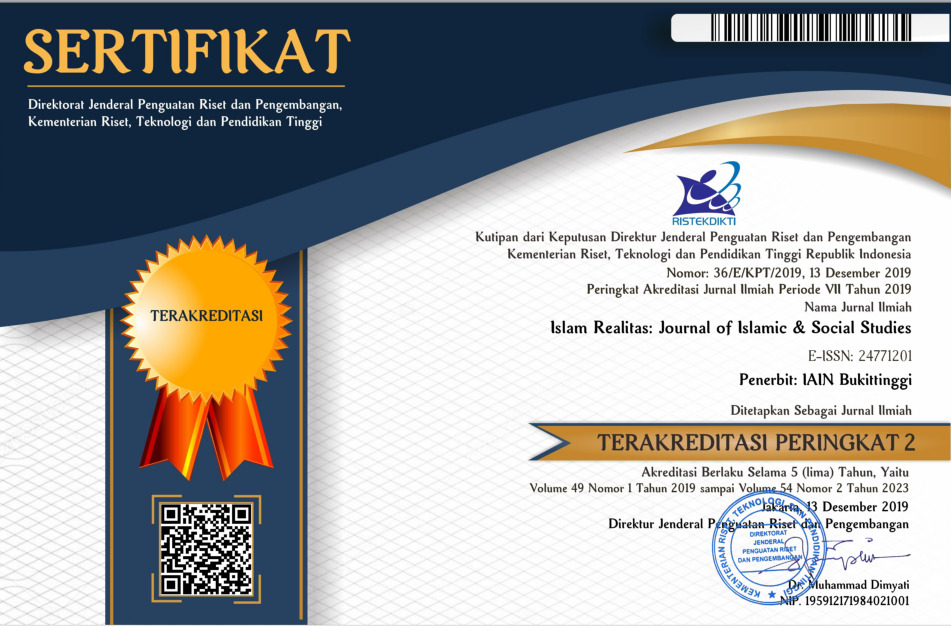Hadarat in Tual City Maluku: The Role of Arab Al-Katiri in Integration of Islam and Local Culture
DOI:
https://doi.org/10.30983/fuaduna.v5i2.4969Keywords:
Arabic Al-Katiri, Local culture, Integration, Islamization, Tual CityAbstract
This paper examines the hadarat tradition as part of integrating Islam with local culture by the Al-Katiri Arab group in Tual City. Attendance is a unique ritual that the people of Tual City carry out in celebrating religious holidays such as Eid al-Fitr, Eid al-Adha, weddings, circumcisions, and other religious activities. The community conducts friendship around the village while dancing accompanied by chanting shalawat to the Prophet Muhammad with music (tambourine) in the hadarat. This article uses a qualitative descriptive method, with observations, interviews, and documentation as the data collection techniques. This article shows that the Al-Katiri Arab community played a role in the spread of Islam in Tual City through trade routes and social and cultural approaches. The descendants of the marriage between the Arab al-Katiri group and the Kei Community of Tual City have been considered one part of the Kei community of Tual City. The information was obtained using historical research methods. Appreciating the culture of the Kei people of Tual City as a form of preaching the spread of Islam is the key to the success of the Al-Katiri Arab group living in harmony amid society with local cultural traditions.
Tulisan ini mengkaji tentang tradisi hadarat sebagai bagian dari strategi mengintegrasikan Islam dengan kebudayaan lokal oleh kelompok Arab Al-Katiri di Kota Tual. Hadarat menjadi sebuah ritual unik yang dilakukan oleh masyarakat Kota Tual dalam merayakan hari besar keagamaan seperti Hari Raya Idul Fitri, Hari Raya Idul Adha, perkawinan, khitanan, dan kegiatan keagamaan lainnya. Masyarakat melakukan silaturahim mengelilingi kampung sambil menari diiringi lantunan shawat kepada Nabi Muhammad dengan musik (rebana) dalam hadarat. Artikel ini menggunakan metode deskriptif kualitatif, dengan observasi, wawancara, dan dokumentasi sebagai Teknik pengumpulan datanya. Hasil peneltian artikel ini menunjukkan bahwa komunitas Arab Al-Katiri berperan dalam penyebaran agama Islam di Kota Tual, melalui jalur perdagangan dan pendekatan sosial dan budaya. Keturunan dari hasil pernikahan antara kelompok Arab al-Katiri dengan Masyarakat Kei Kota Tual sudah dianggap sebagai satu bagian dengan masyarakat Kei Kota Tual. Informasi tersebut didapatkan dengan menggunakan metode penelitian sejarah. Menghargai kebudayaan masyarakat Kei Kota Tual sebagai suatu bentuk dakwah penyebaran agama Islam merupakan kunci kesuksesan kelompok Arab Al-Katiri hidup rukun di tengah-tengah masyarakat dengan tradisi budaya lokal.Â
References
A. Bazher, Ambarak. Islam Di Timor Timur. Jakarta: Gema Insani Press, 1995.
Abdullah, Taufik. “Dari Timur Islam Nusantara, Maluku Utara.†Jurnal Penelitian Humano 9, no. 1 (2018): 231–40.
Azra, Azyumardi. Jaringan Ulama Timur Tengah Dan Kepulauan Nusantara Abad XVII & XVIII: Akar Pembaruan Islam Indonesia. Perenial. Jakarta: Kencana, 2013.
Berg, L.W.C. Van Den. Hadramaut Dan Koloni Arab Di Nusantara. Jakarta: INIS, 1989.
Daliman, A. Islamisasi Dan Perkembangan Kerajaan-Kerajaan Islam Di Indonesia. Yogyakarta: Ombak, 2012.
Fahrudin, Ali. “Masuknya Islam Di Maluku Tenggara Dan Peran Masjid Al-Mukarromah Sebagai Basis Penyebarannya.†Jurnal Lektur Keagamaan 14, no. 1 (2016): 55–84.
Handoko, Wuri. “Perniagaan Dan Islamisasi Di Wilayah Maluku.†Kalpataru 22, no. 1 (2013): 17–30.
Kholil, Munawar. “Naskah-Naskah Islam Papua.†Jumantara: Jurnal Manuskrip Nusantara 7, no. 1 (2016): 167–84.
Loupatty, Stenly R. “Sejarah Kota Tual.†Jurnal Penelitian 6, no. 5 (2013): 92–133.
Pattiasina, Jacquelin. “Aktualisasi Ungkapan-Ungkapan Tradisional Dalam Kehidupan Masyarakat Kei (Evav) Kabupaten Maluku Tenggara,†2011, 1–11.
Safira, and Ali Haidar. “Perkembangan Komunitas Pedagang Arab Di Surabaya Tahun 1870-1928.†Avatara 2, no. 1 (2014): 232–42.
Samsul Munir, Amin. Sejarah Peradaban Islam. Jakarta: Amzah, 2013.
Suryan, Suryan. “Toleransi Antar Umat Beragama: Perspektif Islam.†Jurnal Ushuluddin 23, no. 2 (January 2017): 185. https://doi.org/10.24014/jush.v23i2.1201.
Tiwery, Weldemina Yudit. “Larvul Ngabal Dan Ain Ni Ain Sebagai Pemersatu Kemajemukan Di Kepulauan Kei Maluku Tenggara.†Jurnal Sosiologi Pedesaan 14, no. 1 (2018): 8–15.
Toatubun, F. Arifin. Sejarah Pendidikan Islam Di Kota Tual. Yogyakarta: Bumi Intaran Anggota Ikapi, 2018.
Tule, Philipus, and et.al. Wacana Identitas Muslim Pribumi NTT. Maumere: Penerbit Ledalero, 2015.
Wekke, Ismail Suardi. “Islam Dan Adat : Tinjauan Akulturasi Budaya Dan Agama Bugis.†Analisis 13, no. 1 (2013): 27–56.
Interviews
Ahmad Tamherwarin (Kei Traditional Figure), Interview, June 25, 2019
Al-Katiri, Andi (Head of Arab Family Harmony in Tual and Kabupeten Southeast Molluca), Interview, June 23, 2019
Idham Ohoiwer (Traditional Figure), Interview, 2021.
Rusli Kilwo (Traditional Figure), Interview, 2019.
Sanusi Ahmad (Traditional Figure), Interview, 2021.
Downloads
Published
Issue
Section
Citation Check
License
Authors who publish with this journal agree to the following terms:
- Authors retain copyright and grant the journal right of first publication with the work simultaneously licensed under a Creative Commons Attribution-ShareAlike 4.0. that allows others to share the work with an acknowledgment of the work's authorship and initial publication in this journal.
- Authors are able to enter into separate, additional contractual arrangements for the non-exclusive distribution of the journal's published version of the work (e.g., post it to an institutional repository or publish it in a book), with an acknowledgment of its initial publication in this journal.
- Authors are permitted and encouraged to post their work online (e.g., in institutional repositories or on their website) prior to and during the submission process, as it can lead to productive exchanges, as well as earlier and greater citation of published work (See The Effect of Open Access).







